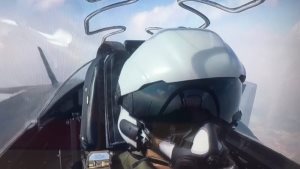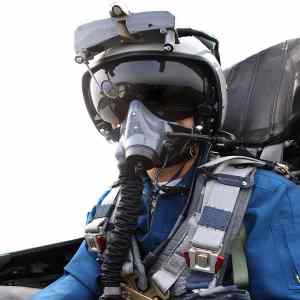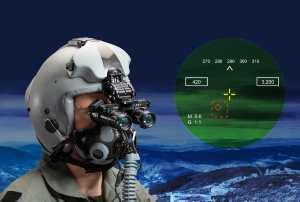Keikō HMD

The Keikō Helmet-Mounted Display is a helmet-mounted display system jointly developed in Menghe and Dayashina and fielded by both nations. By means of a reflector eyepiece and a magnetic reference sensor, it projects targeting markers, navigation indicators, and other key information into the pilot's field of view, allowing the pilot to conduct critical tasks while looking away from the instruments and head-up display. This includes the ability to display contacts below the aircraft, effectively letting the pilot look at radar returns through the floor of the cockpit. The helmet's targeting function allows the pilot to lock certain high off-boresight missiles, like the YGG-5 Dando, onto targets outside the plane's own radar cone, simply by looking at them directly. These capabilities offer a major advantage in combat, and the helmet can easily be reverse-integrated into existing fighter aircraft.
Name
The Dayashinese designation for the helmet, Keikō (炯光), is meant to be a play on 眼光炯々, gankō-keikei, meaning "eagle-eyed" or "having sharp eyesight." It also happens to be a homonym for "tendency" or "inclination" (written 傾向). A popular theory also holds that chief designer Yamada Genjirō chose a designation which would sound like the name of his granddaughter Keiko (恵子), though in this case the second syllable uses the short "o" sound.
In Menghe, the helmet received the less memorable formal designation Type 115 helmet-mounted display and targeting system, or Type 115 helmet for short. At first, it was marketed as Hyŏnggwang, the Menghean reading of the characters 炯光. This was later supplemented by kaego (캐고), the phonetic transliteration of keikō, which in turn was back-translated into Gomun characters as 开高 as a marketing and publicity tool.
Development

The development of the Keikō HMD was subject to a long and tortuous series of delays, many of them stemming from conflicting design requirements and bureaucratic infighting.
The Menghean Ministry of National Defense formally recognized the need for a helmet-mounted display in 2006, shortly after the Ummayan Civil War, where Menghean pilots were left at a disadvantage in skirmishes with Tyrannian pilots. Menghe already operated the Letnian ZSh-5 system, a swing-down pointing reticle used to mark off-boresight targets for the YGG-5 Dando missile, but this was not designed to display information other than the missile's lock status. Meanwhile, Dayashinese private engineers had been working on a helmet-mounted display system for several years, and this was stalling in expectation of a contract for Striker HMD systems from Tír Glas.
Following the Ummayan Civil War, Tyran blocked the sale of Striker helmets to Menghe via Tír Glas, and imposed a similar restriction on Dayashina, fearing that the technology in the helmets might be transferred to Menghe. Representatives of the Menghean MoND traveled to Nakazara in September of that year to propose a joint project, offering generous funding, and after some negotiations on the background conditions, the two countries signed a Memorandum of Understanding on the development of a joint helmet-mounted display.
Although the announcement was met with great fanfare, the actual project ran into trouble early on. Menghean Army and Navy representatives insisted that the helmet be made as light as possible even if it meant sacrificing some capability, a tradeoff which the Dayashinese military was unwilling to make.
A similar debate broke out over the distribution of manufacturing. The Menghean MoND offered to do most of the production and assembly in Menghe to reduce procurement costs, but Dayashinese representatives initially refused due to concerns over Menghean quality control, prompting Menghean negotiators to walk out of high-level talks in protest. Delays, revisions, and redundant work also resulted in skyrocketing unit costs, which prompted criticism from pacifist parties in Dayashina and procurement staff in Menghe. By early 2014, seven years into development, the Dayashinese Diet was reportedly considering a bill to withdraw funding for the project.
The mindset on both sides changed with the outbreak of the Innominadan Crisis, which threw Menghean pilots into live-fire air combat once again and raised tensions between the AVA and the nascent Menghe-Dayashina-Tír Glas bloc. Concerned over air-to-air losses against the already battered Innominadan air force, the Menghean Ministry of National Defense ordered swift completion of the project through a compromise prototype. Dayashinese representatives agreed, and the struggling program was jump-started on an amended set of requirements. Advances in electronics over the previous eight years allowed for considerable weight and space savings over the earlier prototypes, and before long, both Menghe and Dayashina were satisfied with the helmet's characteristics. The first deliveries to front-line squadrons were made in 2016, with multiple assembly centers - two in Menghe, one in Dayashina - and a streamlined supply chain speeding up production.
Design
Layout
The core feature of the Keikō HMD is a holographic reflector sight extending down in front of the user's right eye from its mount on the visor section. This projects information into a circle covering 20 degrees of the pilot's field of view. Targeting information is fed directly from the plane's computer, allowing for a high degree of sensor fusion, and the helmet can also receive datalinked targeting information from other nearby planes, especially useful when finding enemy aircraft above, below, or outside the radar's search zone.
The Keikō helmet tracks the pilot's head movements by means of a magnetic field reference sensor in the helmet and a magnet in the rear of the seat. This system can be retrofitted onto an existing fighter in less than a day, making conversion of existing aircraft relatively straightforward.
In addition to its visual interface, the helmet can provide signals directly to the helmet's radio earpiece, easily issuing warnings and updates without interfering in the field of view. In turn, the pilot can provide voice commands for certain non-critical functions.
The electronics are all contained in the lower rear of the helmet, to balance the weight of the visor and holographic sight in the upper front. The use of modern digital and solid-state systems helps keep weight and space to a minimum.
Night vision
Unlike some other HMD systems, the Keikō helmet does not feature a night vision camera in its base version. It does, however, feature an easy convertibility system: the pilot can remove the daytime visor from its mount on the helmet front, stow it safely, and mount a pair of special night vision goggles in its place, using the same helmet-front clip. These goggles directly interface with the helmet's electronics, and can project indicators and other information into the wearer's field of view. The interchangeable optics approach keeps the helmet lightweight in either configuration by omitting otherwise redundant features, and a properly trained pilot can switch optics with only one free hand.
A tradeoff of this approach is that if a given mission will require both nighttime and daytime operations, or operations during sunrise or sunset, the pilot must carry both the daytime visor and the night vision goggles. In a small fighter cockpit, space considerations may not permit this. Interim Menghean practice has been to time missions to concentrate combat on one side or the other of the divide; meanwhile, work is underway on Keikō-II, which will incorporate a central night vision camera.
Ergonomics
As a result of changes made in the final stages of development, the Keikō helmet is relatively light among Septentrion's HMDs. Total weight of the helmet, including oxygen mask, is reportedly no greater than 1.9 kilograms. The helmet's center of gravity is also relatively close to that of the pilot's head, allowing for reduced neck fatigue, easier endurance in high-G turns, and faster pointing of the helmet. The system has earned favorable reviews from pilots, even when used in the cramped cockpit of the Daesŭngri DS-9.
To allow optimal fit and reduce slippage, the interior of each helmet is custom-fitted to the head of its pilot. The interior is lined with a proprietary Dayashinese artificial padding intended to maximize comfort and conform snugly to the skull. Because the helmet components are fully modular, if a pilot retires, his or her helmet's components can all be fitted to a new custom-made interior lining.
Safety
During development, the designers conducted extensive wind tunnel tests and computer simulations to ensure that the helmet would not cause injury to the pilot during high-speed ejection. Ejection speeds of over 900 kilometers per hour are considered moderate-risk, and ejection speeds of over 1200 kilometers per hour are considered high-risk.
For further safety, the helmet is wired directly to the pilot's vest, which is wired to the ejector seat, which is wired to the cockpit. This ensures that if the plugs fail to detach on ejection, there will be no sudden tugging forces on the pilot's head or body.
Keikō-K
The Keikō-K, with K indicating kunren (training), is a special training variant of the Keikō helmet first displayed in 2017. In addition to the base model's navigation and targeting capabilities, it can also draw on stored data to project simulated formation-flying partners and ground and air threats, improving advanced-stage training and coordination in combat exercises.
Most importantly, because the helmet is modular in construction, a training-electronics module can be switched into any existing helmet with minimal work. This means that cadets who graduate into front-line units can continue using the helmet shells custom-fitted to their heads, and front-line pilots can use training modules for military exercises.
Keiko-II
First displayed at a 2019 defense exposition, the Keikō-II is an updated version of the helmet with new electronics and improved capabilities. To reduce eye fatigue with the right-eye sight, it has a clear OLED display in front of each eye, allowing for binocular projection. The OLED system is also lighter and more compact than the preceding reflector sight. The model on display included a lens centered in the forehead section just above the visor, leading to speculation that it might include integral night vision, projecting feed from the IR camera directly onto the lenses.
Further reading
- Keikō marketing video (Dayashinese): https://www.youtube.com/watch?v=LbqWD8htHxA
- Keikō marketing video (Menghean): https://www.youtube.com/watch?v=S8O7wYTgpSM
